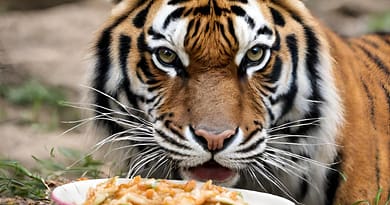What Do Tasmanian Tigers Eat? Exploring the Dietary Habits of Thylacines
Introduction:
The Tasmanian tiger, scientifically known as Thylacinus cynocephalus, was a carnivorous marsupial native to Tasmania, Australia, and New Guinea. Despite its name, the Tasmanian tiger was not a tiger at all but rather a unique and elusive species known for its striped back, dog-like appearance, and pouch. Unfortunately, the last known Tasmanian tiger died in captivity in 1936, making it extinct. However, understanding the dietary habits of these mesmerizing creatures is crucial for appreciating their ecological role. In this article, we will delve into the intriguing question: What do Tasmanian tigers eat?
The Diet of Tasmanian Tigers in the Wild
Tasmanian tigers were carnivorous predators with a diverse diet that varied based on their habitat and availability of prey. Their diet consisted of:
Main Prey of Tasmanian Tigers
- Kangaroos and Wallabies: These marsupials formed a significant portion of the Tasmanian tiger’s diet. They targeted smaller kangaroo species, such as the pademelon and bettong, as well as wallabies like Bennett’s wallaby. Tasmanian tigers were skilled hunters and used their powerful jaws and sharp teeth to capture and subdue their prey.
- Wombats: Tasmanian tigers were known to hunt wombats, particularly the common wombat. They would ambush these stocky marsupials in their burrows or catch them in open areas, utilizing their speed and agility to overpower them.
- Possums: Possums were also on the menu for Tasmanian tigers. These nocturnal arboreal creatures, such as the common brushtail possum, provided an additional food source for the thylacines.
- Birds: Tasmanian tigers were opportunistic hunters and would not hesitate to prey on birds when the chance arose. They targeted ground-dwelling birds like the mutton-bird and pheasants that were within their hunting range.
Other Potential Food Sources
- Insects: While larger mammals formed the primary part of their diet, Tasmanian tigers were not averse to consuming insects, including beetles, grasshoppers, and other small invertebrates. However, these made up only a small fraction of their overall food intake.
- Carrion: Tasmanian tigers were known to scavenge on carrion, feeding on the remains of animals that had already died. This scavenging behavior allowed them to supplement their diet, especially during periods when prey was scarce.
Hunting Techniques of Tasmanian Tigers
 Tasmanian tigers were solitary hunters that relied on stealth and ambush tactics to capture their prey. Some of their hunting techniques included:
Tasmanian tigers were solitary hunters that relied on stealth and ambush tactics to capture their prey. Some of their hunting techniques included:
Nocturnal Adaptations
- Nocturnal Activity: Tasmanian tigers were primarily nocturnal, meaning they were most active during the night. This behavior allowed them to take advantage of the cover of darkness and surprise their prey more effectively.
- Quiet Approach: They possessed a lightweight build, enabling them to move silently through the underbrush. This stealthy approach increased their chances of getting close to their target without being detected.
- Powerful Jaws: Tasmanian tigers had strong jaws and sharp teeth, which they used to deliver a fatal bite to their prey. Their bite was known to be capable of crushing bones, allowing them to incapacitate their victims swiftly.
Chasing and Ambushing Tactics
- Pursuit Hunting: Tasmanian tigers were skilled runners, capable of chasing down prey over short distances. They would employ bursts of speed to close the gap between them and their target before delivering a decisive attack.
- Ambush Attacks: In addition to pursuit hunting, Tasmanian tigers would also rely on ambush tactics. They would patiently wait in hiding, camouflaged by their stripes, and launch a sudden attack when their prey came within range.
FAQs about the Diet of Tasmanian Tigers
Did Tasmanian tigers eat fish?
While there is limited scientific evidence to support this, it is believed that Tasmanian tigers might have consumed fish occasionally, especially if they encountered them near water bodies.
Did Tasmanian tigers eat livestock?
There have been reports of Tasmanian tigers preying on livestock, including sheep and poultry, particularly in areas where human activities encroached on their natural habitat. However, such incidents were relatively rare.
What led to the extinction of Tasmanian tigers?
The extinction of Tasmanian tigers was primarily caused by a combination of factors, including habitat loss, hunting by humans, and the introduction of non-native predators like foxes and dogs. These factors led to a decline in their population and eventual extinction.
Conclusion:
The dietary habits of Tasmanian tigers were diverse, with their diet consisting mainly of kangaroos, wallabies, wombats, possums, and birds. They were skilled hunters who employed a combination of stealth, pursuit, and ambush tactics to capture their prey. While their extinction has left us with limited knowledge about their dietary preferences, understanding what Tasmanian tigers ate is crucial for appreciating their role in the ecosystem. By unraveling the mysteries of these fascinating creatures, we can gain a deeper understanding of their place in the natural world and the importance of conservation efforts to preserve other endangered species.
FAQs:
- Did Tasmanian tigers eat fish?
- Did Tasmanian tigers eat livestock?
- What led to the extinction of Tasmanian tigers?
- Are there any efforts to reintroduce Tasmanian tigers to the wild?
- What animals do tigers eat in the wild?
- What do tigers eat for food?









